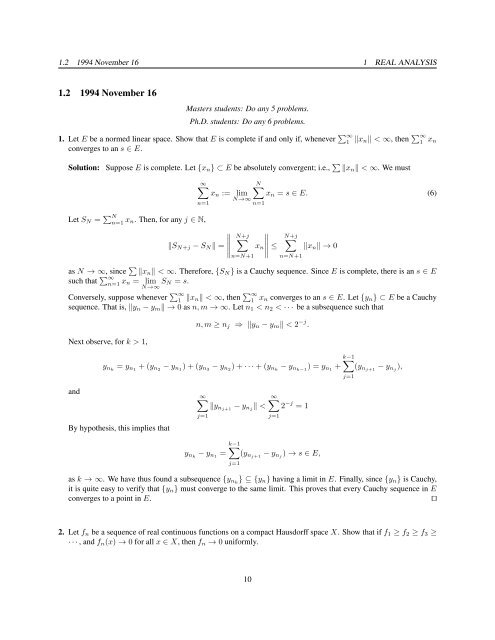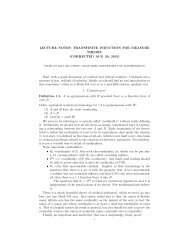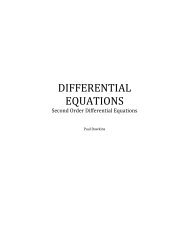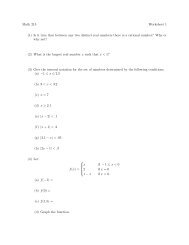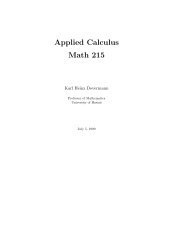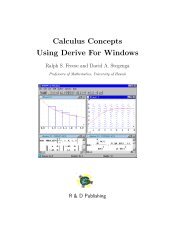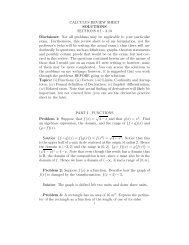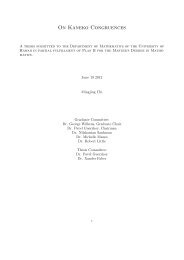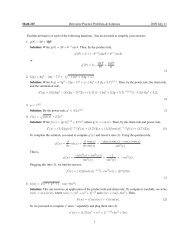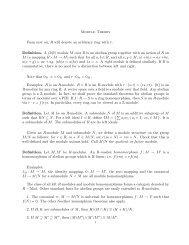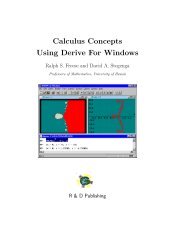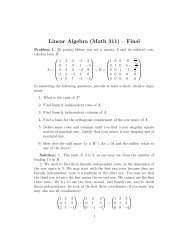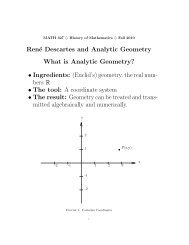Problems and Solutions in - Mathematics - University of Hawaii
Problems and Solutions in - Mathematics - University of Hawaii
Problems and Solutions in - Mathematics - University of Hawaii
Create successful ePaper yourself
Turn your PDF publications into a flip-book with our unique Google optimized e-Paper software.
1.2 1994 November 16 1 REAL ANALYSIS<br />
1.2 1994 November 16<br />
Masters students: Do any 5 problems.<br />
Ph.D. students: Do any 6 problems.<br />
1. Let E be a normed l<strong>in</strong>ear space. Show that E is complete if <strong>and</strong> only if, whenever ∞ 1 xn < ∞, then ∞ converges to an s ∈ E.<br />
Solution: Suppose E is complete. Let {xn} ⊂ E be absolutely convergent; i.e., xn < ∞. We must<br />
∞<br />
xn := lim<br />
n=1<br />
Let SN = N<br />
n=1 xn. Then, for any j ∈ N,<br />
SN+j − SN =<br />
<br />
<br />
<br />
<br />
<br />
N→∞<br />
n=1<br />
N+j <br />
n=N+1<br />
1 xn<br />
N<br />
xn = s ∈ E. (6)<br />
xn<br />
<br />
<br />
<br />
<br />
≤<br />
N+j <br />
n=N+1<br />
xn → 0<br />
as N → ∞, s<strong>in</strong>ce xn < ∞. Therefore, {SN } is a Cauchy sequence. S<strong>in</strong>ce E is complete, there is an s ∈ E<br />
such that ∞ n=1 xn = lim<br />
N→∞ SN = s.<br />
Conversely, suppose whenever ∞ 1 xn < ∞, then ∞ 1 xn converges to an s ∈ E. Let {yn} ⊂ E be a Cauchy<br />
sequence. That is, yn − ym → 0 as n, m → ∞. Let n1 < n2 < · · · be a subsequence such that<br />
Next observe, for k > 1,<br />
<strong>and</strong><br />
ynk<br />
n, m ≥ nj ⇒ yn − ym < 2 −j .<br />
k−1 <br />
= yn1 + (yn2 − yn1 ) + (yn3 − yn2 ) + · · · + (ynk − ynk−1 ) = yn1 +<br />
By hypothesis, this implies that<br />
ynk<br />
∞<br />
j=1<br />
ynj+1<br />
− yn1 =<br />
− ynj <<br />
k−1 <br />
j=1<br />
(ynj+1<br />
∞<br />
2 −j = 1<br />
j=1<br />
− ynj ) → s ∈ E,<br />
j=1<br />
(ynj+1<br />
− ynj ),<br />
as k → ∞. We have thus found a subsequence {ynk } ⊆ {yn} hav<strong>in</strong>g a limit <strong>in</strong> E. F<strong>in</strong>ally, s<strong>in</strong>ce {yn} is Cauchy,<br />
it is quite easy to verify that {yn} must converge to the same limit. This proves that every Cauchy sequence <strong>in</strong> E<br />
converges to a po<strong>in</strong>t <strong>in</strong> E. ⊓⊔<br />
2. Let fn be a sequence <strong>of</strong> real cont<strong>in</strong>uous functions on a compact Hausdorff space X. Show that if f1 ≥ f2 ≥ f3 ≥<br />
· · · , <strong>and</strong> fn(x) → 0 for all x ∈ X, then fn → 0 uniformly.<br />
10


